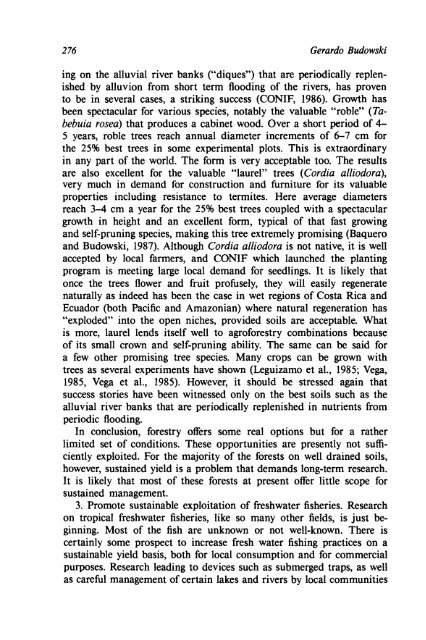Fragile Lands of Latin America Strategies for ... - PART - USAID
Fragile Lands of Latin America Strategies for ... - PART - USAID
Fragile Lands of Latin America Strategies for ... - PART - USAID
You also want an ePaper? Increase the reach of your titles
YUMPU automatically turns print PDFs into web optimized ePapers that Google loves.
2 76 Gerardo Budowski<br />
ing on the alluvial river banks ("diques") that are periodically replen-<br />
ished by alluvion from short term flooding <strong>of</strong> the rivers, has proven<br />
to be in several cases, a striking success (CONIF, 1986). Growth has<br />
been spectacular <strong>for</strong> various species, notably the valuable "roble" (Ta-<br />
bebuia rosea) that produces a cabinet wood. Over a short period <strong>of</strong> 4-<br />
5 years, roble trees reach annual diameter increments <strong>of</strong> 6-7 cm <strong>for</strong><br />
the 25% best trees in some experimental plots. This is extraordinary<br />
in any part <strong>of</strong> the world. The <strong>for</strong>m is very acceptable too. The results<br />
are also excellent <strong>for</strong> the valuable "laurel" trees (Cordia alliodora),<br />
very much in demand <strong>for</strong> construction and hrniture <strong>for</strong> its valuable<br />
properties including resistance to termites. Here average diameters<br />
reach 3-4 cm a year <strong>for</strong> the 25% best trees coupled with a spectacular<br />
growth in height and an excellent <strong>for</strong>m, typical <strong>of</strong> that fast growing<br />
and self-pruning species, making this tree extremely promising (Baquero<br />
and Budowski, 1987). Although Cordia alliodora is not native, it is well<br />
accepted by local farmers, and CONIF which launched the planting<br />
program is meeting large local demand <strong>for</strong> seedlings. It is likely that<br />
once the trees flower and fruit pr<strong>of</strong>usely, they will easily regenerate<br />
naturally as indeed has been the case in wet regions <strong>of</strong> Costa Rica and<br />
Ecuador (both Pacific and Amazonian) where natural regeneration has<br />
"exploded" into the open niches, provided soils are acceptable. What<br />
is more, laurel lends itself well to agr<strong>of</strong>orestry combinations because<br />
<strong>of</strong> its small crown and self-pruning ability. The same can be said <strong>for</strong><br />
a few other promising tree species. Many crops can be grown with<br />
trees as several experiments have shown (Leguizamo et al., 1985; Vega,<br />
1985, Vega et al., 1985). However, it should be stressed again that<br />
success stories have been witnessed only on the best soils such as the<br />
alluvial river banks that are periodically replenished in nutrients from<br />
periodic flooding.<br />
In conclusion, <strong>for</strong>estry <strong>of</strong>fers some real options but <strong>for</strong> a rather<br />
limited set <strong>of</strong> conditions. These opportunities are presently not suffi-<br />
ciently exploited. For the majority <strong>of</strong> the <strong>for</strong>ests on well drained soils,<br />
however, sustained yield is a problem that demands long-term research.<br />
It is likely that most <strong>of</strong> these <strong>for</strong>ests at present <strong>of</strong>fer little scope <strong>for</strong><br />
sustained management.<br />
3. Promote sustainable exploitation <strong>of</strong> freshwater fisheries. Research<br />
on tropical freshwater fisheries, like so many other fields, is just be-<br />
ginning. Most <strong>of</strong> the fish are unknown or not well-known. There is<br />
certainly some prospect to increase fresh water fishing practices on a<br />
sustainable yield basis, both <strong>for</strong> local consumption and <strong>for</strong> commercial<br />
purposes. Research leading to devices such as submerged traps, as well<br />
as careful management <strong>of</strong> certain lakes and rivers by local communities

















